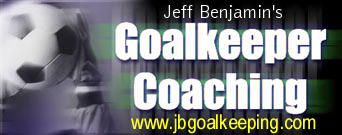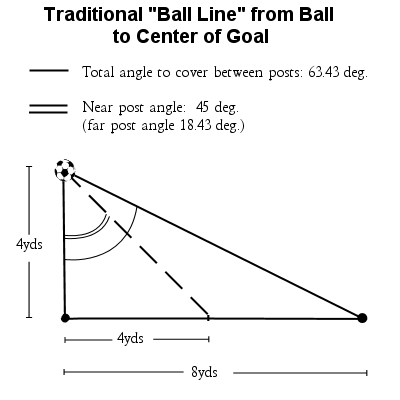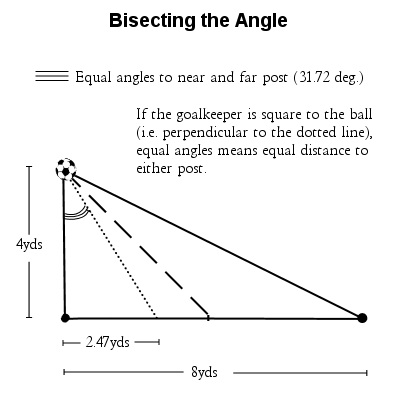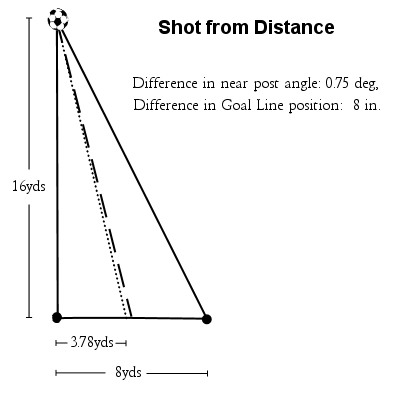
|
"Outstanding keeper instruction. This is a must for goalkeepers and coaches." —Ottawa Internationals S.C. web site, Ottawa, Canada |

|

|
Top |
Goalkeeping Tips, Tidbits and Random Thoughts
An athlete talking to themsleves during competition is hardly a new phenomenon.... The talk does not have to be vocal. By merely thinking you are talking to yourself and sending a message.
-- Tony DiCicco, Goalkeeper Soccer Training Manual
If you have a question, comment or rebuttal you'd like to see addressed here, send me email. I will post your mail to the blog at my discretion unless you specify otherwise.
Bisecting the angle
I spent some time discussing angle play with another coach, and looked over my previous entry on angles. I realized how using the "ball line" as a positioning tool breaks down once the ball gets close to goal.What we really want to do as goalkeepers is to take up a position that bisects the angle that needs to be covered, not one that bisects the goal line. When the ball gets close to goal and is not dead center, these two lines are quite different.
If you're mathematically inclined, you could probably do a general proof of this (knock yourself out!), but here's an example. We'll place the ball even with one of the goalposts so we can use right triangles and high-school trig. In the first diagram, the ball is even with the left post and 4 yards off the goal line. The goal is 8 yards wide, so here's the angles for the "traditional" ball line:

If you measure the angles this gives you, the angle to the near post is 63.43 degrees; the angle to the far post is only 18.43 degrees. We are obviously way too far towards the far post!
What we really want to do is to take up a position that bisects the total angle we have to cover. This position is indicated by the dotted line. If the keeper is square to the ball (in other words, perpendicular to the line of bisection), this means the keeper has an equal distance to cover either post:

Obviously, this covers the goal much better. It is shifted towards the near post significantly from the center of the goal.
Now, once the ball gets farther away from goal, or the ball is closer to the center of the goal, the difference between the two is very small and using the "ball line" as a starting point works just fine. Here's how the angles change if the ball is even with the left post but 16 yards out. The difference in angles is less than a degree, and a goalkeeper on the goal line needs to only adjust by 8 inches, or less if they're off the line:

So we can still use the ball line to the center of the goal as a guideline and starting point, but goalkeepers should learn to (and probably instinctively do anyway) split the angle they have to cover in two.
Labels: Footwork and positioning
Old school
 I was going through some photos the other day, and found one that is definitely old school. It's circa 1979 or 1980. Shaggy hair. Short shorts. Gloves? My first pair of Uhlsports with the rubber ping-pong paddle grip were still months away. Special keeper jerseys? Not on your life, just shiny adidas polyester long-sleeve shirt with a wide collar. The white boots completed the look.
I was going through some photos the other day, and found one that is definitely old school. It's circa 1979 or 1980. Shaggy hair. Short shorts. Gloves? My first pair of Uhlsports with the rubber ping-pong paddle grip were still months away. Special keeper jerseys? Not on your life, just shiny adidas polyester long-sleeve shirt with a wide collar. The white boots completed the look.Labels: Miscellaneous
Are we having fun yet?
Those games I officiated on Sunday put me in a sour mood for the rest of the evening. I wondered: if you're not having any fun, why even be out on the pitch? After all, soccer is a game. Whether we're a player, coach, referee or spectator, we're at the park to enjoy ourselves and have a good time. And sometimes we need to be reminded of that.From a player's and coaches point of view, there are additional benefits. If you're having fun, you will probably be more relaxed and perform better. Nothing is more detrimental to athletic performance than "tightening up". Athletes who are "in the zone" tend to be relaxed and let things happen as they come; external factors seem to disappear.
Personally, a few seasons back I had a poor season as a goalkeeper. I mishandled a few balls and turned what could have been wins into draws, draws into losses. I simply wasn't having any fun. So the next season out, my big adjustment was to remind myself to relax and have fun out on the field. Guess what? I had one of my best seasons ever, and we won the league! Just by remembering that soccer should be fun.
Labels: Psychology
No whining
I spent four hours on the soccer field yesterday and didn't have much fun at all. How could that be? I was wearing a striped shirt and carrying a whistle or flag, instead of playing or coaching. Why wasn't it any fun? Because the teams I was officiating seemed determined not to have any fun either.The whining in both games started from the opening whistle. Whining at teammates, opponents, and the most convenient target, the referees. Three red cards and numerous yellows later, nobody walked away happy.
As a referee, let me tell you that whining about calls or trying to "game" the ref seldom gets you anywhere. In fact, if the ref gets annoyed at the constant badgering, do you really think he's going to give you the benefit of the doubt on a 50-50 challenge? Or if you "cry wolf" on every little knock, he'll see it differently if you really do get cleaned out? This goes all the way up to the pros: look at the reputation that FC Porto, the Champion's League finalists, have earned themselves.
Griping about the ref takes your focus away from the game. Whether they are good, bad or indifferent, referees must be considered part of the field conditions. You adjust to them the way you adjust to sun, wind or rain. (A referee instructor I had put it this way: "The ref is part of the field. The field is made of dirt. Therefore... referees are dirt!") The team that focuses on playing soccer and adjusts better to the referee that day will usually come out on top... and yesterday, that's just how it happened, by a scoreline of 4-1 in both games.
Labels: Laws, Psychology
Stance is critical
It is often overlooked, but the goalkeeper's stance is absolutely critical. I see many, many goalkeepers whose stance is too upright. Tony Waiters has a saying that a goalkeeper's stance should be more like a gorilla's than a marine's, and it's absolutely true. An upright stance brings a number of problems:- It becomes very difficult to get down to low shots.
- Related to the above, the goalkeeper is giving away the easiest shot for a striker to score on--the simple push pass right by the goalkeeper's feet.
- The goalkeeper is less balanced, making quick footwork more difficult.
- The keeper tends to lead with their feet.
- It is difficult to get power into dives and leaps.
Simply bending the knees and getting lower (while still keeping the head and shoulders up) will solve all of the above. For example, a low stance helps with both low dives and high dives. For low balls, if you start low it's easier to get to the ground quickly, and the hands are already down there to get to the ball first. For high balls, a low stance "pre-loads" the legs so the keeper gets a good push and power step to get the towards the crossbar.
Try working with your keepers on a lower stance than they usually use, and see how it helps!
Labels: Footwork and positioning